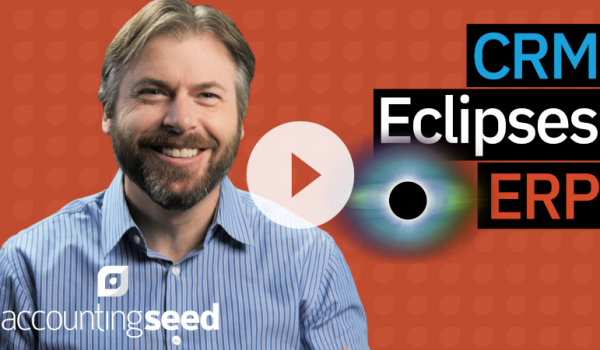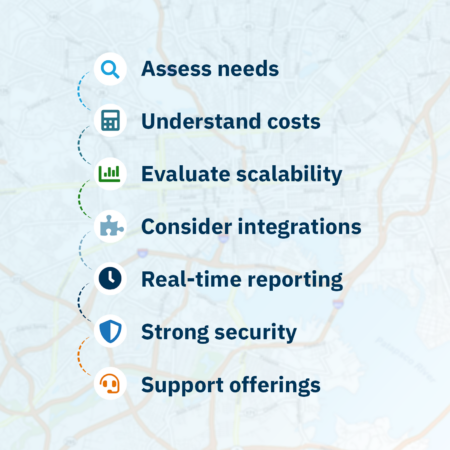
Author: Tony Zorc, CEO & Founder of Accounting Seed
All businesses seek the best ways to save money, boost productivity, and organize workflow. Information technology, of course, has become a major resource in accomplishing these goals. However, technology, especially in the business world, has NOT all evolved at the same rate. Over time some platforms become more advanced and comprehensive than others. This has been the case with the Customer Relationship Management (CRM) IT environment. The advanced properties of CRM have led it to utterly eclipse the long-reigning Enterprise Resource Planning (ERP) system as the central hub of the organization’s IT system.
The power-shift story of ERP to CRM is similar to other tech stories where the incumbent is blindsided. Specifically, the role of the internet in software technology. We’ve seen this pattern multiple times already, like how Netflix’s use of streaming videos online led it to topple Blockbuster. Even more recently, Uber’s use of a mobile app has given the company a significant edge over traditional taxis. Technology is always changing, and so do the needs and demands of the users. Today especially, technology needs to be able to adapt to the user in order to be a true resource. This is what would lead to the CRM eclipsing ERP.
An IT Big Bang and the Rise of ERP
Back in the early 1970’s, there were very few computers being used in business. Every process from selling a product to recording the accounting was done by hand and recorded on paper. However, computer programs began to drastically streamline this work. The first business-related use for computers was actually accounting; beginning in the late 1970s we saw the rise of several accounting applications. These accounting applications were very successful, reducing manual data entry and enabling users to maintain financial records more easily. These innovations expedited and enhanced business processes like never before. They encouraged developers to create more functionality to offer alongside accounting. This directly led to the birth of ERP.
ERPs Provide a One-Size-Fits-All System
Developers knew that accounting is essential for every business. They also wanted to add other important functions into one IT ecosystem. However, this presented a challenge. Each industry operates differently, even relying on industry-specific functions. Developing specific operations for every type of business would be nearly impossible for a single application provider. Especially the early accounting software groups. Instead, developers added software for the most prominent cross-industry operations. ERPs traditionally include back office and operations features. Accounting, procurement, resource planning, scheduling, and other related features just to name a few. These features play integral roles in managing many types of business. However, they aren’t enough for a modern workplace that utilizes cloud computing.
Most ERPs today retain the old-fashioned mindset that “we” (the software maker) know how to best run your operation. And you should adapt your business to the way we do things. This mindset was largely derived from the capabilities of computing technology right when ERP was first created in the 1970s. As a result of the times, software makers developed rigid apps with little flexibility. This isn’t to say that ERP designers wanted to restrict users. At the time, they simply couldn’t see how the web would enable unique businesses to become more dynamic.
The Rise of CRM
Over the next few decades, computing technology and the internet rapidly grew to influence and manage everything about business. CRM was started around 1993 as a system to manage sales and customer relations. Essentially, CRM and ERP represented two sides of the same coin. ERP concentrated on back-office functions like managing money and operations. CRM organized how customers were acquired and retained. Things like prospect tracking, pipeline reporting, and sales automation, are the traditional core functions. What gave CRM the strategic edge over ERP was flexibility.
During the 90s, CRM makers recognized that the ERP paradigm did not work well for sales teams. Individual organizations use different sales strategies and calculate commissions differently. Therefore, the platform had to be adaptable. CRM software had to be very flexible in order to enable businesses to grow and maintain business relationships. For CRMs like Salesforce to be successful, they couldn’t be constricted to a single mold or process. Additionally, computing technology has evolved significantly since the 1970s. Most organizations held a basic understanding of how to use it. This gravitation towards the internet and technology led to a significant shift in the mindset of how IT platforms should work.
The Power of Paradigms: Why CRM Eclipses ERP
Designs literally define the technology, just as with anything else, the central paradigms of CRM and ERP would shape how they would be used and grow. The central paradigm of which CRM was founded upon is really the opposite of ERP. For the most part, an ERP system will give a base that you can use to manage your business, but you’re forced to conform business operations to that basic structure. This can be problematic because even within a single industry, businesses operate differently. Therefore, the reporting and overall operation of individual businesses will be unique – especially now with so many options that tech offers.
ERP Apps Lack Customization
Most ERP applications are very difficult, if not impossible, to customize because of their legacy structure. They can’t adjust for differential or unconventional business models and practices. The amount of divergence in modern-day businesses makes it essential for business IT to accommodate a variety of factors. This framework is great for consistency, but when you need something different from the typical software mold and can’t get it, your business suffers.
CRM’s paradigm is centered around the individual business using the software assuming they know how to best run the business process. Therefore, CRM platforms like Salesforce.com give you a toolset that lets you dictate the IT structure entirely around how you need it to be for your business, instead of just a base. Since 1995 the comparative flexibility of CRM over ERP led companies to centralize more data and processes on CRM. CRM became a magnet that attracted the movement of any business process that needed to be tweaked for the company. By 2008 companies such as Accounting Seed brought accounting and other back office programs onto the CRM platform.
Will CRM Make ERPs Obsolete?
If one was to picture an eclipse, one sphere rapidly taking over the space of another, this basically encapsulates the relationship between CRM and ERP. CRM has overtaken ERP, but the foundations of ERP are still useful. This is how Accounting Seed comes into play.
As a CRM, Salesforce was developed to allow for a range of functions and business requirements – whatever an individual needs. Accounting Seed was developed to mirror this flexibility. We built accounting software with a CRM mindset to fit Salesforce. This gives the user the chance to basically create their own ERP with the flexibility of a CRM. Our accounting functions are designed to be highly customizable; reporting and key processes can be automated to the user’s specifications. This relationship makes Salesforce and Accounting Seed work like bookend applications on a single, highly customizable platform. Companies can build one holistic system for the entire business to be run on that maintains accurate data without the strain of jumping between multiple platforms. We’ve bridged the two systems, essentially making CRM the new ERP and so much more.
See Accounting Seed in action
Get a close-up view of how accounting on Salesforce can eliminate the need for costly integrations—and silos of mismatched information—by sharing the same database as your CRM.



